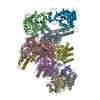+Search query
-Structure paper
| Title | A point mutation in the nucleotide exchange factor eIF2B constitutively activates the integrated stress response by allosteric modulation. |
|---|---|
| Journal, issue, pages | Elife, Vol. 11, Year 2022 |
| Publish date | Apr 13, 2022 |
 Authors Authors | Morgane Boone / Lan Wang / Rosalie E Lawrence / Adam Frost / Peter Walter / Michael Schoof /  |
| PubMed Abstract | In eukaryotic cells, stressors reprogram the cellular proteome by activating the integrated stress response (ISR). In its canonical form, stress-sensing kinases phosphorylate the eukaryotic ...In eukaryotic cells, stressors reprogram the cellular proteome by activating the integrated stress response (ISR). In its canonical form, stress-sensing kinases phosphorylate the eukaryotic translation initiation factor eIF2 (eIF2-P), which ultimately leads to reduced levels of ternary complex required for initiation of mRNA translation. Previously we showed that translational control is primarily exerted through a conformational switch in eIF2's nucleotide exchange factor, eIF2B, which shifts from its active A-State conformation to its inhibited I-State conformation upon eIF2-P binding, resulting in reduced nucleotide exchange on eIF2 (Schoof et al. 2021). Here, we show functionally and structurally how a single histidine to aspartate point mutation in eIF2B's β subunit (H160D) mimics the effects of eIF2-P binding by promoting an I-State like conformation, resulting in eIF2-P independent activation of the ISR. These findings corroborate our previously proposed A/I-State model of allosteric ISR regulation. |
 External links External links |  Elife / Elife /  PubMed:35416150 / PubMed:35416150 /  PubMed Central PubMed Central |
| Methods | EM (single particle) |
| Resolution | 2.8 Å |
| Structure data | EMDB-26098, PDB-7trj: |
| Source |
|
 Keywords Keywords | TRANSLATION / integrated stress response |
 Movie
Movie Controller
Controller Structure viewers
Structure viewers About Yorodumi Papers
About Yorodumi Papers





 homo sapiens (human)
homo sapiens (human)